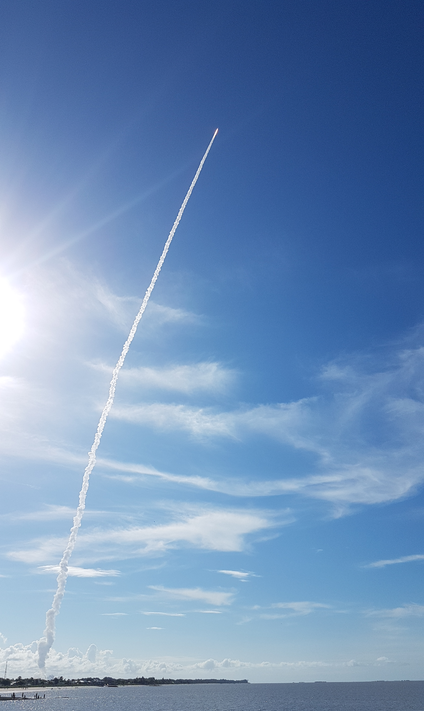

As a measurement engineer at sigma3D, you travel all over the world and see a lot of different locations, but even our colleagues rarely get to see something so special.
Two of our colleagues had the opportunity to work at the European Spaceport. You can read about their impressions and the adversities they encountered in the middle of the jungle here.
Such knowledge and the on-site conditions presented the measurement team with well-known challenges, but not plannable ones. Climatic conditions with temperatures over 30 °C and humidity of up to 90% not only make the work difficult but also forces the equipment. The extreme temperature change during the 10-hour work shifts had to be counteracted by proper controls and compensation strategies. Equally problematic were the sudden tropical rain showers, which repeatedly interrupted the measurements, despite protective measures. In addition to the climatic conditions, there are also animal companions in the primaeval forest. When working on the ground, one has to watch out for tarantulas and snakes, while during the night measurements, one tried to ward off mosquitoes and moths with insect protection and as little light as possible.
Anyone who knows anything about aerospace has heard about the construction of the new Ariane 6 booster rocket and launch facility in Kourou, French Guiana.
Ariane 6 is now to continue the reliability and endurance of Ariane 4 and 5. Later, the modern booster rocket has to fit optimally on the launch pad so, the holding devices must be set up and calibrated accordingly.
OHB Digital Connect, formerly MT Mechatronics, commissioned sigma3D GmbH to measure the booster and sacrificial pallets at the manufacturer's site and carry out corresponding control measurements in Kourou.
Similarly, the alignment of the settling plates for the booster pallets on the launch table was to be mounted with the highest precision.
The Ariane 5 rocket launch that the sigma3D team witnessed at the start of the project also made it clear that if the project is completed successfully, their work will help to keep European space travel competitive.
When measuring the sacrificial pallets, the distances of the three support points to each other should determine in flatness and stitch dimensions. For this purpose, the local plates were determined analogously to the pre-measurement at the manufacturer. The measurements were carried out during the night to create the most stable and constant environmental conditions possible. Difficulties were encountered here in determining the position, as the underside of the pallet had to be measured and, these were only approx. 40 cm, supported on 3 points, above the ground. The provisionally set up pit, which served as a material storage area, also had unevenness and is rather unsuitable for such a measurement if you compare it to a hall.
The solution was a steel plate and two ropes on which the steel plate, including the magnetic base, was pulled lying on the floor under the pallet to be measured. To link the position under the pallet with the one on the pallet, corresponding reference points, so-called nests, were glued for the laser tracker. Due to the multi-part function of PolyWorks, the evaluation could be worked out cleanly for each measurement. Without any further problems, all pallets could be measured required dimensions determined during the night shift.
For the Ariane 6 boosters to have the correct position, the sacrificial pallets had to move into position.
As preparatory work, the sigma3D staff measured into the coordinate system of the launch pad. The previously defined coordinate system of the end customer was stabilized with additional level measurement. The difficulty was to take into account the drift of the table due to solar radiation. The sigma3D team determined and took this into account by extrapolating the expected material expansion based on the temperature curve measured the day before.
The measuring work could then carried out in sigma3D's own very accurate reference system.
For the assembly and adjustment of the sacrificial pallets, steel plates were mounted and positioned beforehand, which were then to hold them.
One solid and two sliding bearings were fitted for each pallet. These were cold-welded with a specific two-component adhesive. The advantage here was the elimination of conventional welding. With conventional welding, there is a risk that the pallets will warp. The unique feature of cold welding was the curing time of just 15 minutes after mixing. Thus, within a short time, the steel plates weighing several tons had to be adjusted to tolerances of one-tenth of a millimetre using grub screws and hammers.
When the schedule was changed at short notice in the further course of the project, the measurements of the settling plates could not only be carried out during the night as planned, but the measurements also had to be carried out during the day. Here, the influence of the temperature is taken into account through suitable temperature compensation.
Due to the fast and precise work, no significant differences in the measurement accuracies between day and night measurements were found during the control measurements.
The experienced team from sigma3D was always able to answer any metrological questions that arose on site and flexibly fit into the assembly process. For example, it was possible to clarify directly whether the rails for the sacrificial pallets ran parallel and were at the same height level. A great help here was the real-time output of adjustment values, so that the adjustment team could see directly on site whether the achieved adjustment values were within the specification.
All in all, the installation was completed as planned, and we are pleased with the trust placed in us and the opportunity to continue this project.
We, the sigma3D team, are also looking forward to the upcoming launch of the Ariane 6 with excitement and to see how the joint work disappears into space.
